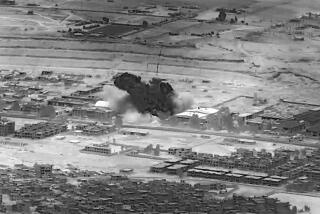U.S. Learning in Iraq, Officials Say
- Share via
WASHINGTON — The ability of Iraqi insurgents to attack U.S. troops and Iraqi civilians has remained constant over the last year, but American forces are slowly gaining better intelligence about them, top Pentagon officials said Tuesday.
After a lull that followed Iraq’s national election in January, the Pentagon has acknowledged that there has been a recent surge in attacks. Arms and money continue to flow to guerrillas, ensuring that they remain a potent force, officials say.
“I think their capacity stays about the same, and where they are right now is where they were almost a year ago,” said Air Force Gen. Richard B. Myers, chairman of the Joint Chiefs of Staff.
At the same time, both Myers and Defense Secretary Donald H. Rumsfeld said more Iraqis were providing valuable intelligence, helping U.S. and Iraqi forces hunting for insurgent leaders.
“As the political process goes forward and as the economic progress goes forward, there’s going to be more intelligence coming from Iraqis, and their insurgency will have a more difficult time and it will be losing more people,” Rumsfeld said during a briefing he and Myers held with reporters.
Myers cited a February raid in which U.S. troops came close to capturing Abu Musab Zarqawi, a Jordanian widely thought to be leading insurgent attacks in Iraq, and raids last week in which U.S. and Iraqi forces rounded up 10 guerrillas they believe were responsible for shooting down a helicopter Thursday, killing 11 civilians, including six Americans.
“I think in general the intelligence is getting better. Having said that, we still don’t have Zarqawi,” Myers said.
Rumsfeld and Myers said that the level of insurgent violence -- roughly 40 to 50 attacks per day -- was comparable to 12 months ago. Myers’ assessment of the insurgency’s strength was more sober than that given by other senior U.S. commanders in recent weeks.
Last month, Army Gen. John P. Abizaid, the top U.S. military commander in the Mideast, told Congress he believed the guerrilla movement against U.S.-led forces was fizzling. The inability of insurgents to derail the Jan. 30 election, Abizaid said, was a sign that their capacity to plan and execute attacks was diminishing.
In November, after an American assault on the insurgent stronghold of Fallouja, Marine Lt. Gen. John F. Sattler said U.S. forces had “broken the back” of the insurgency.
More than 1,570 U.S. troops have died in Iraq and more than 12,000 have been wounded since the beginning of the war, according to Pentagon figures. After more than 100 U.S. military deaths in January, casualty tolls have declined sharply.
Despite the strength of the insurgency, both Myers and Rumsfeld said that progress was being made, particularly in the training of Iraqi forces, which Rumsfeld said was key to securing the country.
Myers said the number of insurgent attacks was a poor measure of the progress of the U.S.-led military effort, given that many of the attacks missed their targets and caused no injuries. The actual picture in Iraq, he said, is more complex.
Toward the end of the briefing, the two officials were asked simply, “Are we winning?”
Rumsfeld fielded the question and responded with a long explanation, saying that Iraqis, not Americans, would have to defeat the insurgency, and offering reasons why insurgents would ultimately fail.
Myers finally cut off his boss.
“I’m going to say this,” Myers declared. “I think we are winning. OK? I think we’re definitely winning. I think we’ve been winning for some time.”
More to Read
Sign up for Essential California
The most important California stories and recommendations in your inbox every morning.
You may occasionally receive promotional content from the Los Angeles Times.













